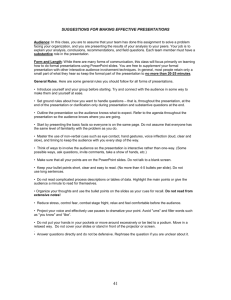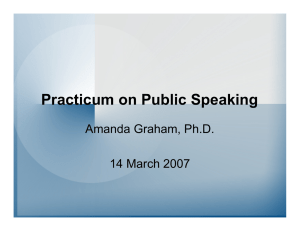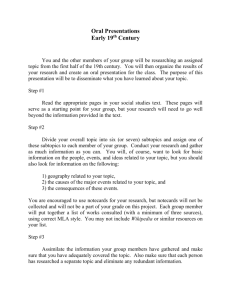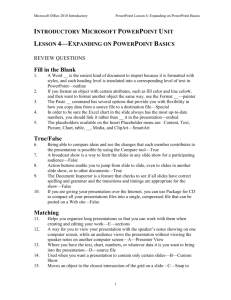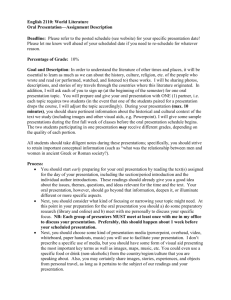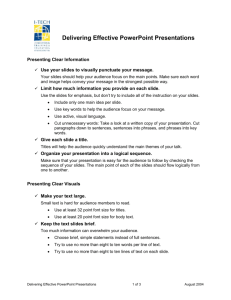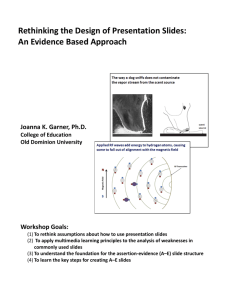Presenting
advertisement
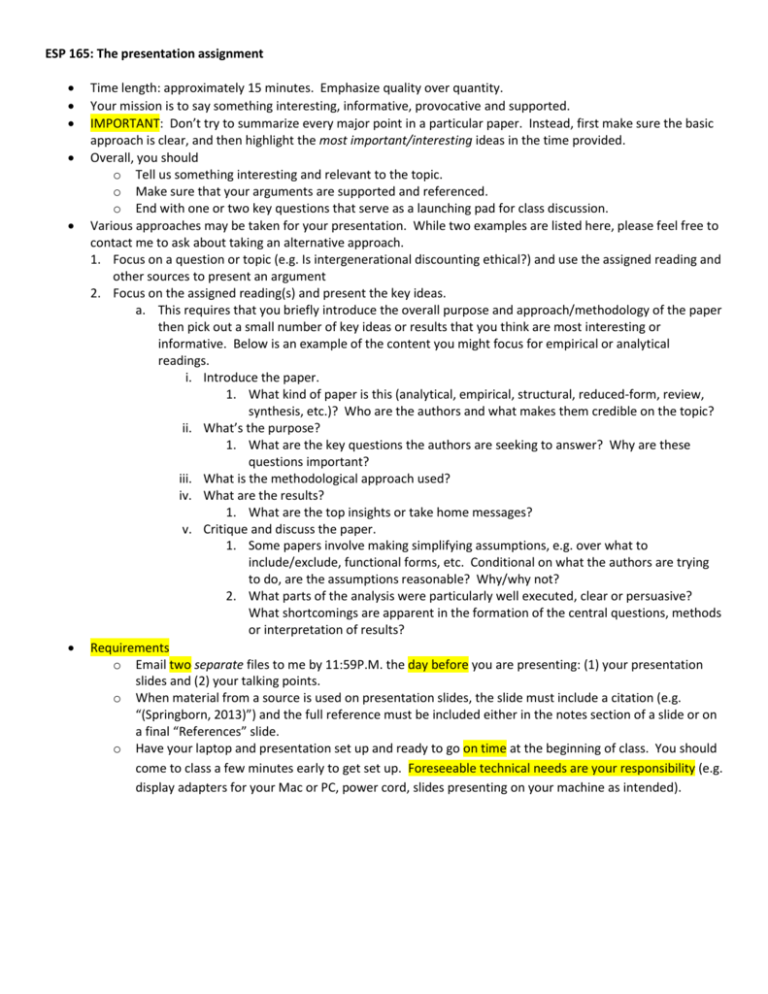
ESP 165: The presentation assignment Time length: approximately 15 minutes. Emphasize quality over quantity. Your mission is to say something interesting, informative, provocative and supported. IMPORTANT: Don’t try to summarize every major point in a particular paper. Instead, first make sure the basic approach is clear, and then highlight the most important/interesting ideas in the time provided. Overall, you should o Tell us something interesting and relevant to the topic. o Make sure that your arguments are supported and referenced. o End with one or two key questions that serve as a launching pad for class discussion. Various approaches may be taken for your presentation. While two examples are listed here, please feel free to contact me to ask about taking an alternative approach. 1. Focus on a question or topic (e.g. Is intergenerational discounting ethical?) and use the assigned reading and other sources to present an argument 2. Focus on the assigned reading(s) and present the key ideas. a. This requires that you briefly introduce the overall purpose and approach/methodology of the paper then pick out a small number of key ideas or results that you think are most interesting or informative. Below is an example of the content you might focus for empirical or analytical readings. i. Introduce the paper. 1. What kind of paper is this (analytical, empirical, structural, reduced-form, review, synthesis, etc.)? Who are the authors and what makes them credible on the topic? ii. What’s the purpose? 1. What are the key questions the authors are seeking to answer? Why are these questions important? iii. What is the methodological approach used? iv. What are the results? 1. What are the top insights or take home messages? v. Critique and discuss the paper. 1. Some papers involve making simplifying assumptions, e.g. over what to include/exclude, functional forms, etc. Conditional on what the authors are trying to do, are the assumptions reasonable? Why/why not? 2. What parts of the analysis were particularly well executed, clear or persuasive? What shortcomings are apparent in the formation of the central questions, methods or interpretation of results? Requirements o Email two separate files to me by 11:59P.M. the day before you are presenting: (1) your presentation slides and (2) your talking points. o When material from a source is used on presentation slides, the slide must include a citation (e.g. “(Springborn, 2013)”) and the full reference must be included either in the notes section of a slide or on a final “References” slide. o Have your laptop and presentation set up and ready to go on time at the beginning of class. You should come to class a few minutes early to get set up. Foreseeable technical needs are your responsibility (e.g. display adapters for your Mac or PC, power cord, slides presenting on your machine as intended). Grading rubric Content o Stays focused on appropriate topic o Communicates a clear and precise understanding of key concepts and of all visual or other supporting material presented. o Encourages audience involvement during and especially at end of presentation (e.g.) by proposing thoughtful/provocative questions o Makes effective use of slides o Majority of slides implement assertion-evidence format; consistently states key point or argument of the slide in title with relevant visual evidence below o Uses text sparingly; avoids reading extended text from slides; avoids using slides as a teleprompter Editing, referencing and logistics o Laptop and presentation set up and ready to go on time (foreseeable technical needs addressed) o Meets length requirements o References are from appropriate sources and are properly cited and referenced o Meets the standard for grammar, spelling, punctuation o Materials (slides and talking points) submitted on time Common feedback from previous presentations: … come up with a key argument that represents the main point of the slide and presenting this in the title. For example, as opposed to titling a slide “the Big Players” what do you think was the most important takeaway lesson from the slide? …. push even further in this direction with more nuanced arguments. For example, a relatively simple argument to make takes the general form of “For issue X, we have numerous/many/several options/examples/alternatives.” This kind of assertion sets you up to present a simple list. This is ok but not striking. An assertion that highlights tensions or tradeoffs is more powerful. Some of your slides were quite text heavy, serving essentially as talking points (which are better placed in your notes). … try to ensure that the visual closely supports the assertion in the title. … make sure you understand any figures that you’re including. If you’re including a figure you should be prepared to explain to audience exactly what is on each axis at the outset so they know what they’re looking at. One way you might connect even more effectively with your audience in the future would be to plan out how you might get the audience involved early on in your presentation. You did an excellent job of getting people involved early and transitioned well into discussion at the end with some thoughtful questions. You made nice use of external sources (e.g. the video and the Florida example) to provide some additional context. Resources Michael Alley’s website on presentation using the assertion-evidence structure at Penn State: http://www.writing.engr.psu.edu/slides.html o Overview of the assertion-evidence structure for presentations: http://www.writing.engr.psu.edu/slides_body.html o PowerPoint templates (should help you in breaking free from the defaults of PowerPoint) Slide template: full talk (Designed for a scientific talk but easily adaptable for alternative purposes) Slide template: teaching o A YouTube video tutorial on presentation by Michael Alley: http://www.youtube.com/watch?v=d04w4vvByDI&feature=player_embedded o A TED talk by Melissa Marshall on communication (“bullets kill”): www.ted.com/talks/melissa_marshall_talk_nerdy_to_me.html Various web resources for effective presentation: o Pointers for Successful PowerPoint Presentations (basic tips for creating and displaying presentations, covering content, fonts, and color) o Avoiding PowerPoint Perils (overview of common errors, including PowerPoint distractions, overloading and slide reading) o Mortal Sins in Oral Presentations or How to Give a Talk if You Never Want to Talk Again (several useful tips presented in sarcastic “opposite” fashion) o PLoS Ten simple rules for making good oral presentations (a set of 10 rules for effective presentation)
